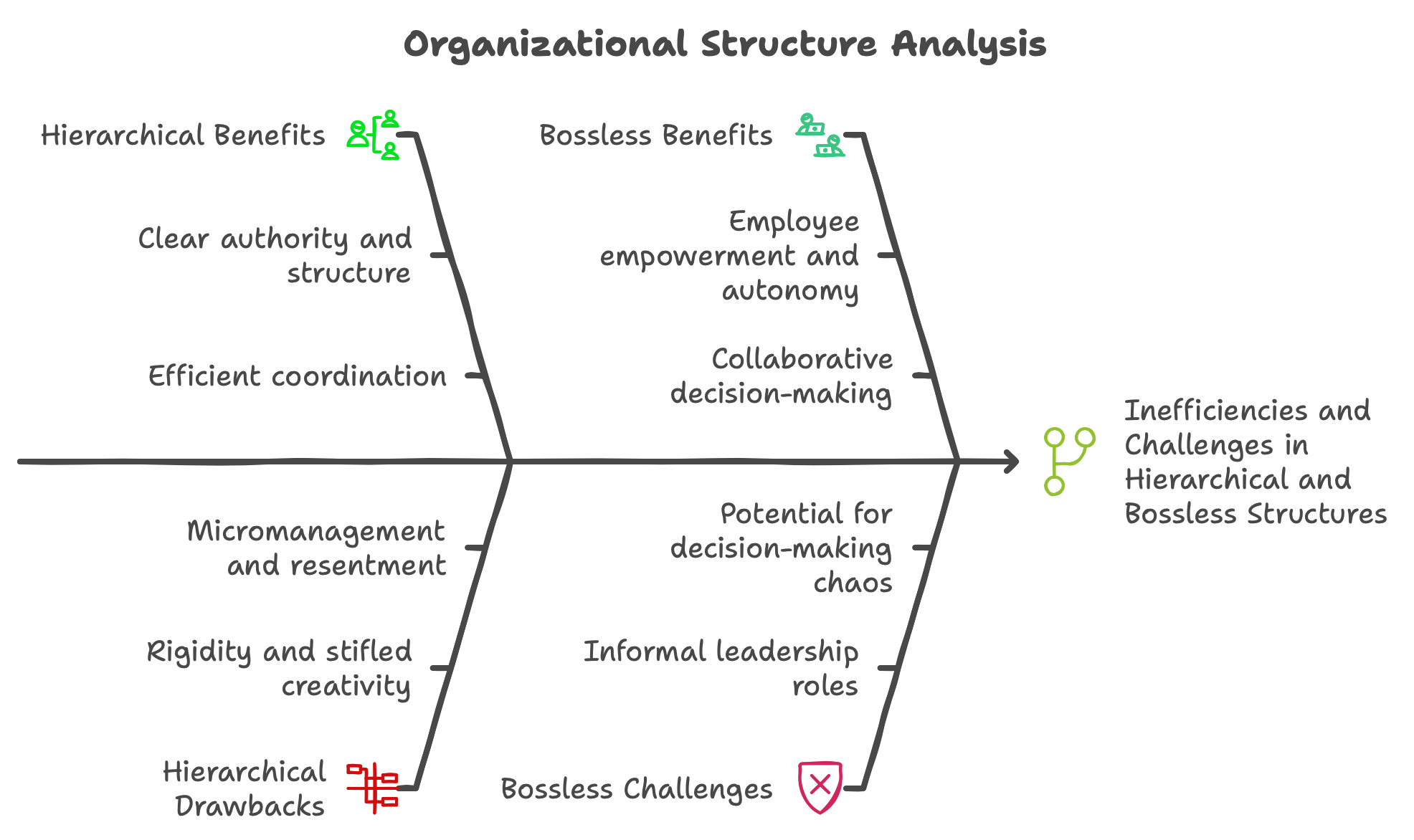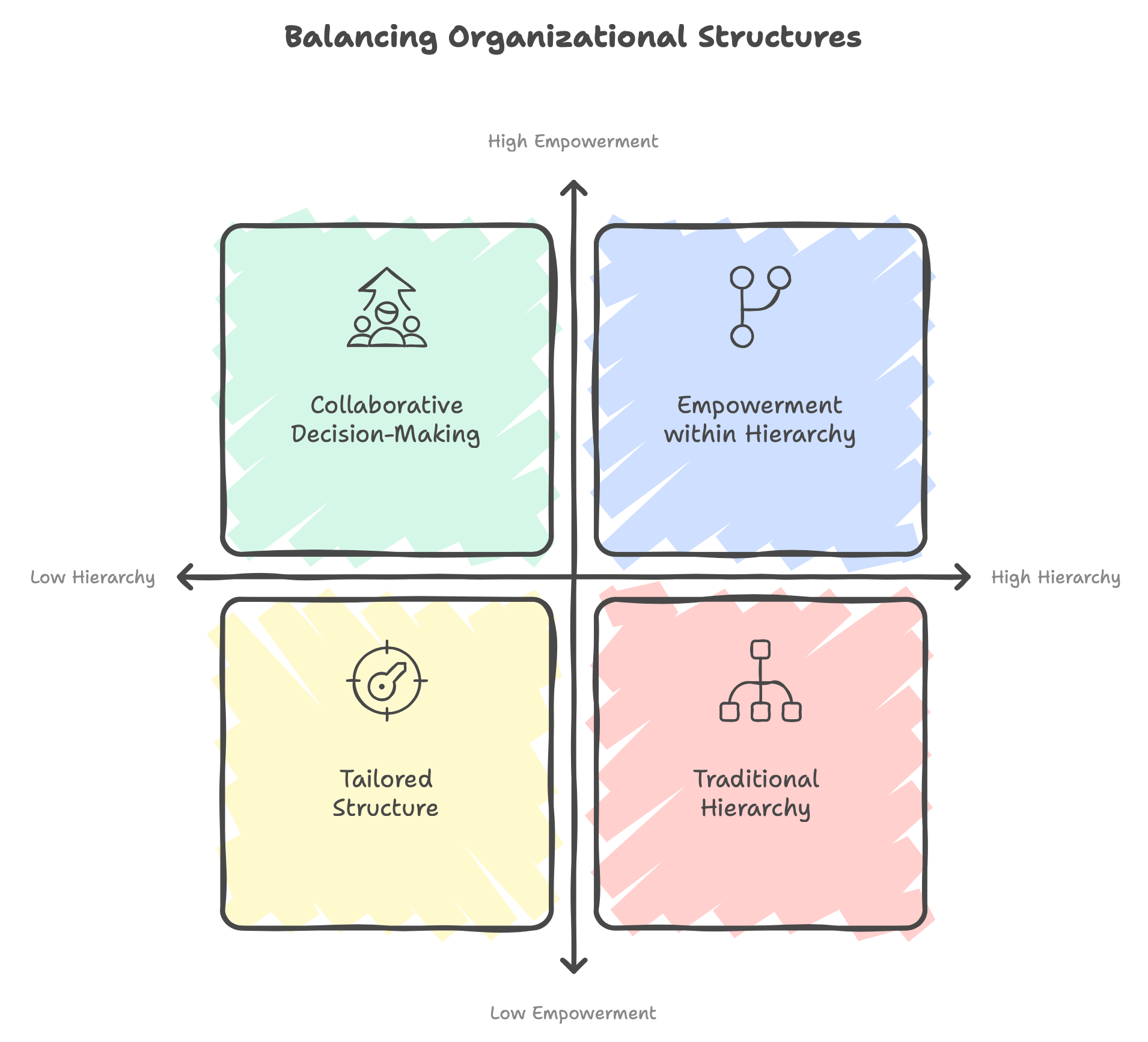Embracing the Best of Both: The Power of Hybrid Organizational Structures
In today's rapidly evolving business landscape, organizations are constantly seeking the most effective and efficient ways to structure their operations. The debate between hierarchical and bossless organizational structures has been a recurring topic of discussion.
While both structures have their merits and drawbacks, finding the right balance between hierarchy and employee empowerment is crucial for long-term success.
In this article, we will delve into the intricacies of these structures, examining their benefits, drawbacks, and proposing a balanced approach that maximizes productivity and fosters a positive work environment.
While both structures have their merits and drawbacks, finding the right balance between hierarchy and employee empowerment is crucial for long-term success.
In this article, we will delve into the intricacies of these structures, examining their benefits, drawbacks, and proposing a balanced approach that maximizes productivity and fosters a positive work environment.

A hierarchical structure refers to a system in which individuals or groups are organized in a pyramid-like structure, with each level having varying degrees of authority and responsibility. Higher-level positions have more decision-making power and control over lower-level positions. In this structure, there is a clear chain of command, with information and instructions flowing from top to bottom.
Hierarchy: Maximizing Coordination and Efficiency
Hierarchical structures have long been the conventional model for organizing businesses. They provide a clear chain of command, defined roles, and established procedures. This structure allows for efficient coordination of complex tasks and enables organizations to achieve their goals effectively.
Key benefits of hierarchy include:
1. Clear authority and structure: Hierarchies establish a framework for accountability, decision-making, and resource allocation. They provide employees with a sense of direction and clarity regarding their roles and responsibilities.
2. Efficient coordination: By dividing tasks and responsibilities among different levels, hierarchical structures enable efficient division of labor, specialization, and smooth information flow. They facilitate effective coordination across departments and teams.
3. Decision-making efficiency: Hierarchies streamline decision-making processes by centralizing authority in higher positions with expertise and a broader perspective. This can lead to quicker and more informed decisions.
However, improper implementation of hierarchy can lead to drawbacks such as rigidity, communication barriers, and the potential for micromanagement. When structure becomes overly rigid, employees may feel constrained and their creativity stifled. Micromanagement can breed resentment and hinder employee autonomy, leading to decreased motivation and job satisfaction. Overcoming hierarchical barriers to honest feedback from employees.
Bossless: Empowerment and Collaboration
Bossless or flat organizational structures have gained attention as an alternative to traditional hierarchies. These structures emphasize employee empowerment, autonomy, and collaboration.
A bossless or flat organizational structure is characterized by the absence of traditional hierarchical levels and the elimination of middle management positions. In a bossless structure, decision-making authority and responsibility are distributed among employees, often through consensus or democratic processes. The focus is on collaboration, autonomy, and shared decision-making.
In a bossless structure, employees are typically empowered to make decisions within their areas of expertise and are encouraged to take ownership of their work. The emphasis is on self-management and collective responsibility rather than relying on formal positions of authority. Experience of making right decisions.
It's important to note that while the term "bossless" suggests the absence of leaders, it doesn't mean there is a complete absence of leadership or guidance. In practice, leaderless organizations often have informal leaders or executives who provide some level of direction and support.
Key characteristics and benefits of bossless structures include:
1. Empowered decision-making: Bossless structures distribute decision-making authority, allowing employees to make decisions within their areas of expertise. This empowers individuals, fosters innovation, and encourages ownership of work.
2. Increased collaboration: With fewer layers of management, bossless structures promote open communication and collaboration. Employees are encouraged to work together, share ideas, and contribute to collective decision-making processes.
3. Flexibility and agility: Bossless structures can facilitate quick decision-making and adaptability in dynamic environments. They allow organizations to respond swiftly to change and take advantage of emerging opportunities.
However, the lack of formal hierarchy in bossless structures can also present challenges. Communication gaps, information silos, and the difficulty of maintaining a true leaderless model are common pitfalls. Without clear roles and authority, decision-making can become time-consuming and potentially lead to ambiguity or conflicts.
Striking the Balance: A Hybrid Approach
While both hierarchical and bossless structures have their strengths, a one-size-fits-all approach may not be suitable for every organization. Striking a balance between hierarchy and employee empowerment is essential. UnitiQ: Helping organizations stay competitive amidst change

Here are key considerations for finding the right mix:
1. Tailor the structure to the organization: Every business is unique, and its structure should align with its goals, type of work, and environment. Assess the organization's specific needs, complexity, and coordination requirements to determine the appropriate level of hierarchy.
2. Empowerment within hierarchy: Even within a hierarchical structure, empowering employees and providing opportunities for decision-making can enhance motivation and engagement. Delegate authority, encourage employee input, and foster a culture that values autonomy and innovation.
3. Collaborative decision-making: Incorporate elements of collaborative decision-making, such as gathering input from cross-functional teams or implementing participatory processes for certain initiatives. This encourages employee involvement and fosters a sense of ownership and commitment to the decisions made.
I'm sure you will be interested in reading Transformation to cross-functional teams.
1. Tailor the structure to the organization: Every business is unique, and its structure should align with its goals, type of work, and environment. Assess the organization's specific needs, complexity, and coordination requirements to determine the appropriate level of hierarchy.
2. Empowerment within hierarchy: Even within a hierarchical structure, empowering employees and providing opportunities for decision-making can enhance motivation and engagement. Delegate authority, encourage employee input, and foster a culture that values autonomy and innovation.
3. Collaborative decision-making: Incorporate elements of collaborative decision-making, such as gathering input from cross-functional teams or implementing participatory processes for certain initiatives. This encourages employee involvement and fosters a sense of ownership and commitment to the decisions made.
I'm sure you will be interested in reading Transformation to cross-functional teams.
UnitiQ: Supporting Organizations in Achieving the Perfect Balance
UnitiQ understands that finding the right balance between structure and employee empowerment is critical to an organization's success. With our fractional HR services, we help businesses implement hybrid organizational models that blend the strengths of both hierarchical and bossless structures.
Our team of HR experts provides tailored solutions that empower employees while maintaining clear roles and efficient decision-making. Whether it’s assisting with talent acquisition, fostering a culture of collaboration, or supporting leadership development, UnitiQ equips organizations with the tools needed to stay adaptable and competitive in today’s fast-paced business environment.
Contact me, Olga Fedoseeva, Fonder at UnitiQ, directly:
My Telegram
My LinkedIn
Our team of HR experts provides tailored solutions that empower employees while maintaining clear roles and efficient decision-making. Whether it’s assisting with talent acquisition, fostering a culture of collaboration, or supporting leadership development, UnitiQ equips organizations with the tools needed to stay adaptable and competitive in today’s fast-paced business environment.
Contact me, Olga Fedoseeva, Fonder at UnitiQ, directly:
My Telegram
My LinkedIn








